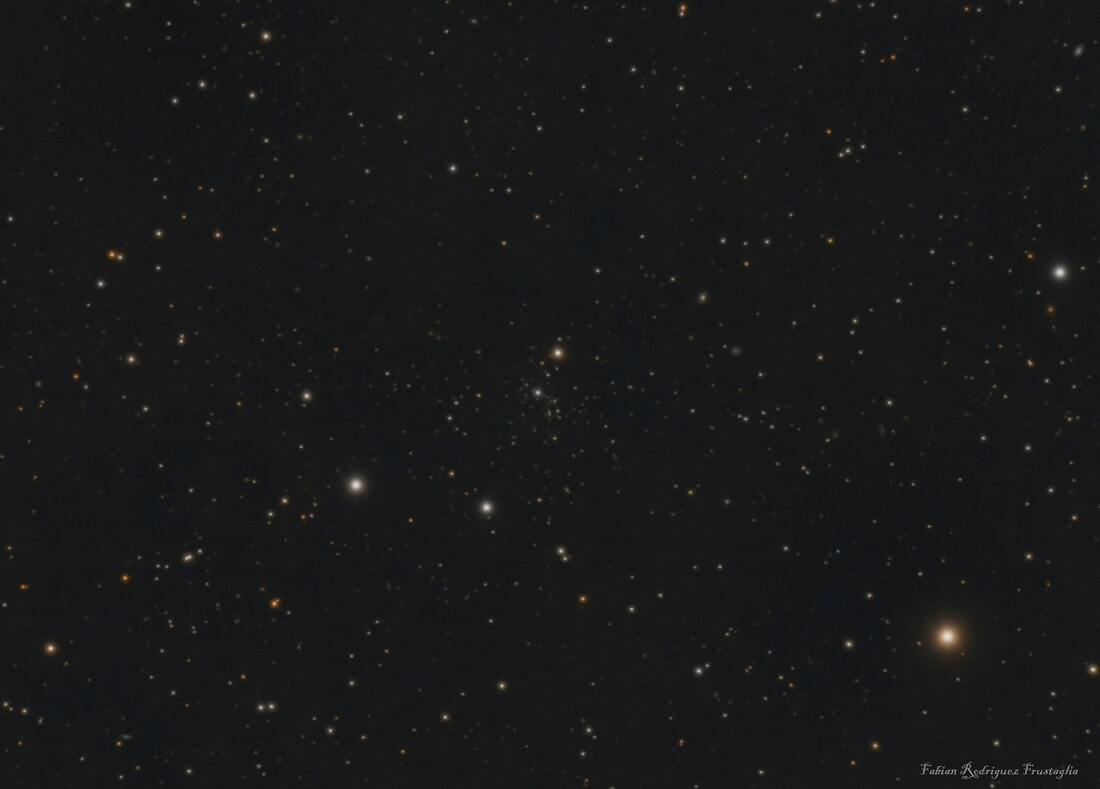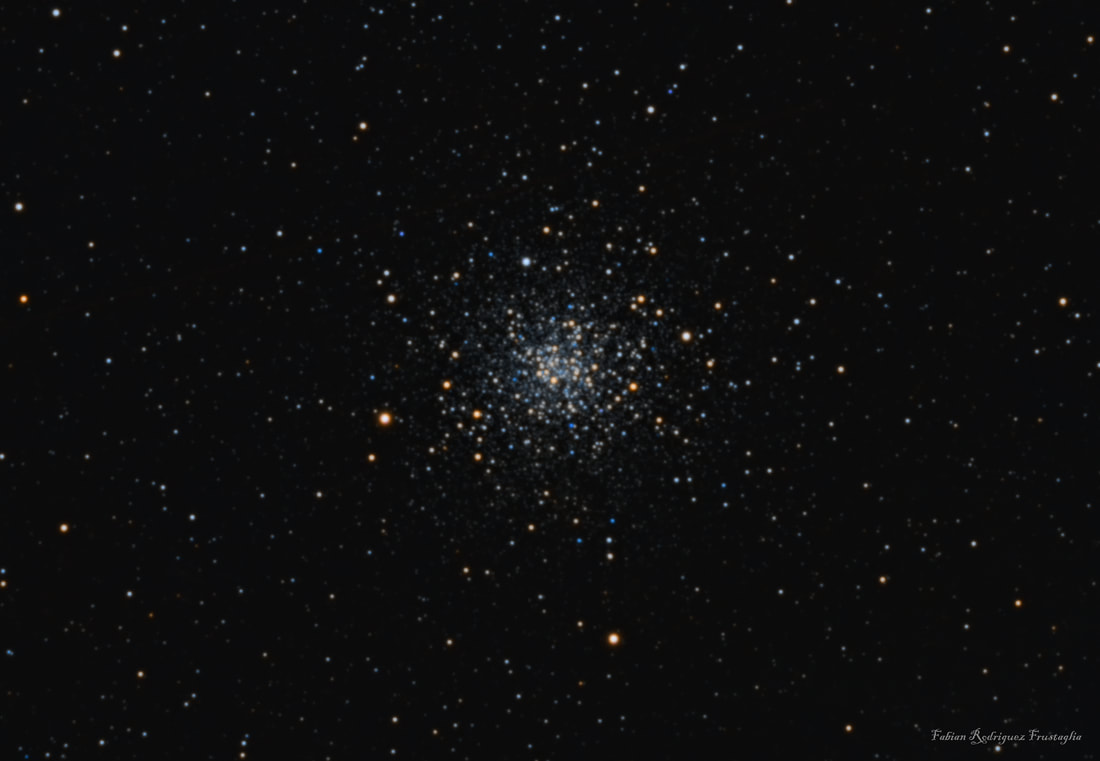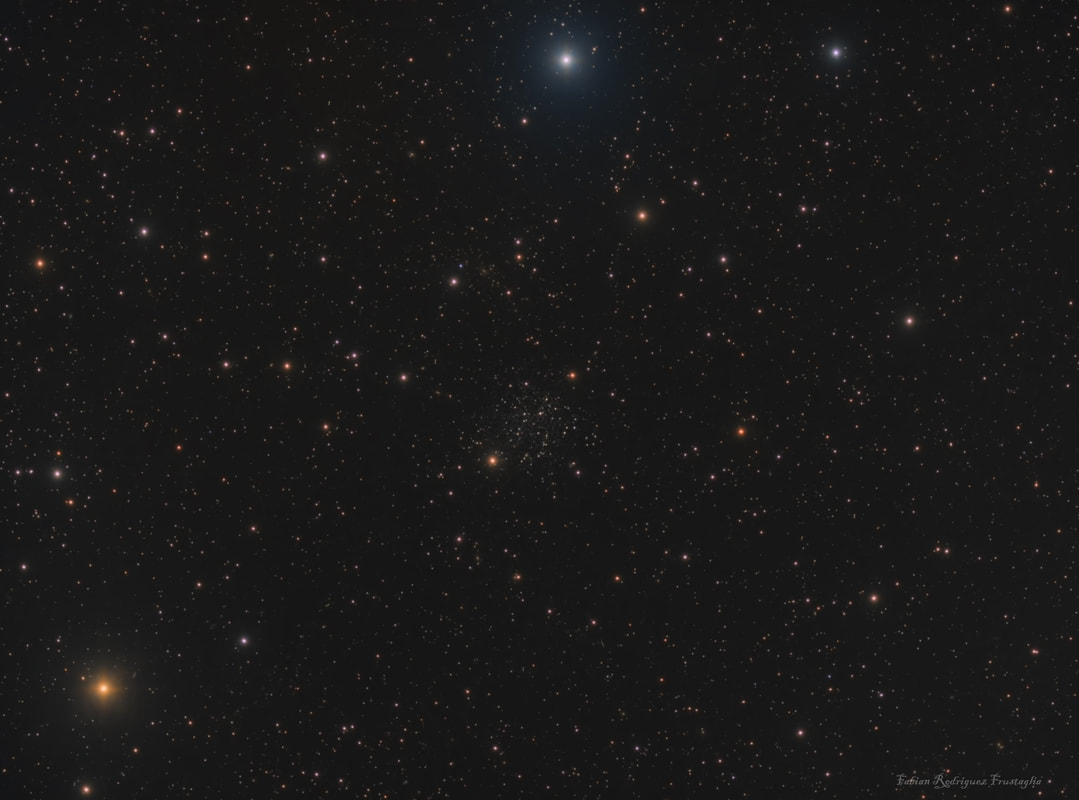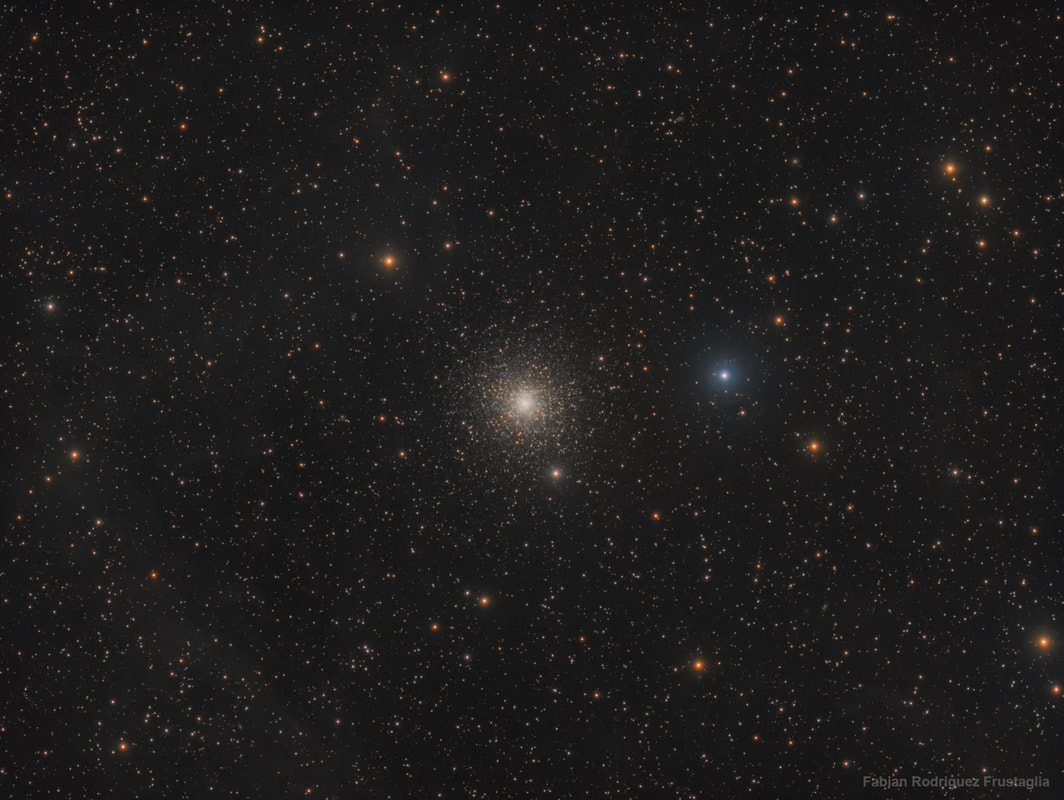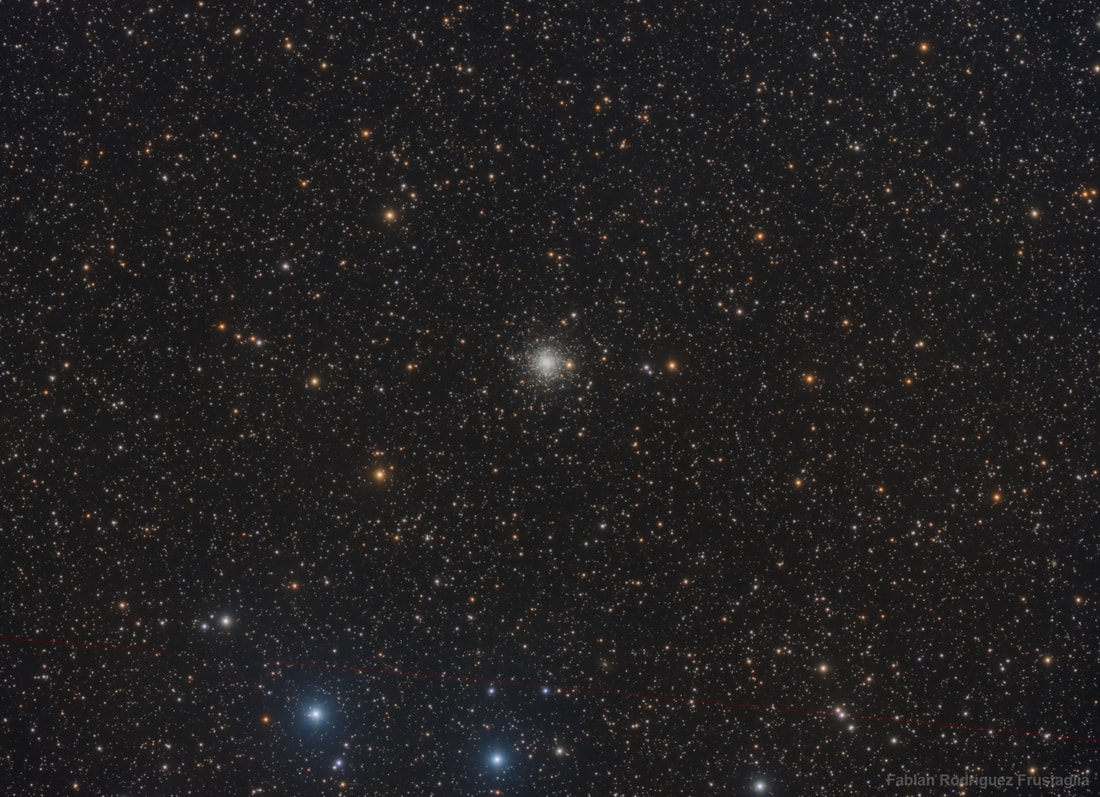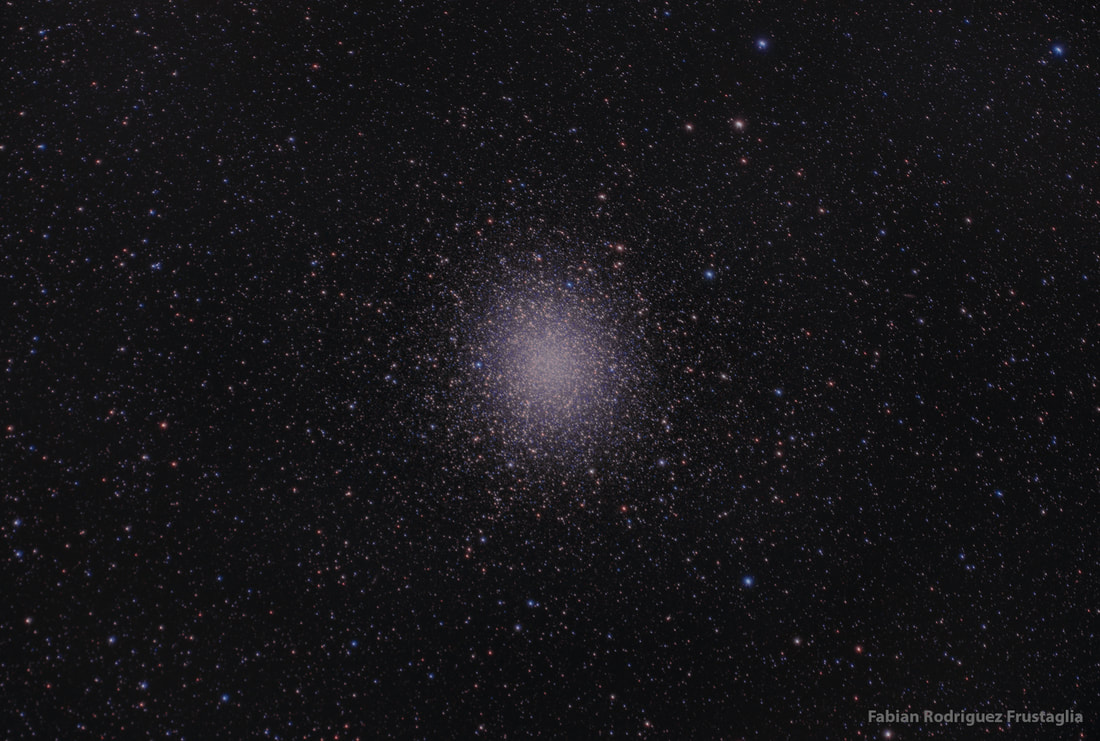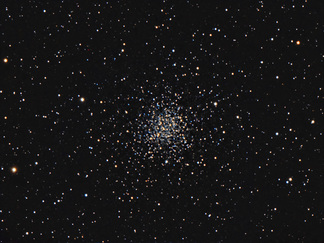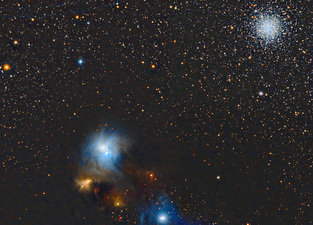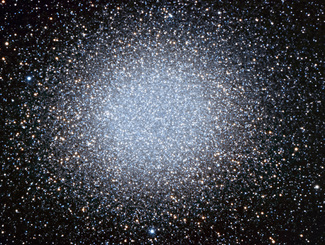Globular Clusters
CLICK ON AN IMAGE TO VIEW IT AT FULL RESOLUTION
|
NGC 7006
NGC 7006 (also known as Caldwell 42) is a globular cluster in the constellation Delphinus. NGC 7006 resides in the outskirts of the Milky Way. It is about 135,000 light-years away, five times the distance between the Sun and the centre of the galaxy, and it is part of the galactic halo. This roughly spherical region of the Milky Way is made up of dark matter, gas and sparsely distributed stellar clusters. Telescope: Meade LX850 12" f/8.0 Camera: QHY268m Filters: Chroma RGB Date: August2022 Exposure: 72 x 300" = 6.00 hrs |
|
Palomar 14
Palomar 14 is a globular cluster located in the constellation Hercules. It is a member of the Palomar Globular Clusters group. Palomar 14 was discovered in 1958 by Sidney van den Bergh and Halton Arp during inspection of the photographic plates from the Palomar Sky Survey. This is a round, diffuse cluster located in the outer halo of the Milky Way galaxy. It is about 3–4 billion years younger than a typical galactic cluster. Telescope: Meade LX850 12" f/8.0 Camera: QHY268m Filters: Chroma RGB Date: May2022 Exposure: 38 x 300" = 3.16 hrs |
|
Messier 107
Messier 107 or M107, also known as NGC 6171, is a very loose globular cluster in a very mildly northern part of the sky in Ophiuchus, and is the last such object in the Messier Catalogue. Telescope: Meade LX850 12" f/8.0 Camera: QHY268m Filters: Chroma RGB Date: May 2022 Exposure: 38 x 300" = 3.16 hrs |
|
Messier 71
Messier 71 (also known as M71 or NGC 6838) is a globular cluster in the small northern constellation Sagitta. It was discovered by Philippe Loys de Chéseaux in 1745 and included by Charles Messier in his catalog of non-comet-like objects in 1780. It was also noted by Koehler at Dresden around 1775.[8] This star cluster is about 12,000 light years away from Earth and spans 27 light-years (8 pc). The irregular variable star Z Sagittae is a member. Telescope: Meade LX850 12" f/5.6 Camera: QHY163m Filters: ZWO RGB Date: September 2021 Exposure: 54 x 300" = 4.50 hrs |
|
Messier 13
Messier 13 or M13, also designated NGC 6205 and sometimes called the Great Globular Cluster in Hercules or the Hercules Globular Cluster, is a globular cluster of several hundred thousand stars in the constellation of Hercules. M13 was discovered by Edmond Halley in 1714, and cataloged by Charles Messier on June 1, 1764 into his list of objects not to mistake for comets; Messier's list, including Messier 13, eventually became known as the Messier Catalog. Telescope: Meade Series 6000 115mm f/5.6 Camera: ZWO ASI 1600 Filters: ZWO RGB Date: March 2021 Exposure: 105 x 300" = 8.75 hrs |
|
Palomar 5
Palomar 5 is a globular cluster discovered by Walter Baade in 1950. After the initial name of Serpens, it was subsequently catalogued as Palomar 5. There is a process of disruption acting on this cluster because of the gravitation of the Milky Way - in fact there are many stars leaving this cluster in the form of a stellar stream. The stream has a mass of 5000 solar masses and is 30,000 light years long. The cluster is currently 60.6 kly from the Galactic Center. It shows a noticeable amount of flattening, with an aspect ratio of 0.62 ± 0.23 between its semimajor axis and semiminor axis. Telescope: Meade Series 6000 115mm f/5.6 Camera: ZWO ASI 1600 Filters: ZWO LRGB Date: March 2021 Exposure: 73 x 300" = 6.08 hrs |
|
NGC 4147
NGC 4147 is a globular cluster in the Coma Berenices constellation. This is a relatively small globular cluster, ranking 112th in luminosity among the Milky Way globular cluster population. It is considered an Oosterhoff type I cluster (OoI), despite having a relatively low metallicity. Indeed, it has the lowest metallicity of any OoI cluster known. There are 19 RR Lyrae variable star candidates and as many as 23 blue stragglers. A high proportion of the latter are concentrated near the dense core of the cluster, which is consistent with the idea that blue stragglers form through stellar mergers. Telescope: Meade Series 6000 115mm f/5.6 Camera: ZWO ASI 1600 Filters: ZWO RGB Date: March 2021 Exposure: 90 x 300" = 7.50 hrs |
|
Messier 53 & NGC 5053
Messier 53 (also known as M53 or NGC 5024) is a globular cluster in the Coma Berenices constellation. M53 is one of the more outlying globular clusters, being about 60,000 light-years (18.4 kpc) LY away from the galactic center, and almost the same distance (about 58,000 light-years (17.9 kpc)) from the Solar system. NGC 5053 is the another globular cluster in the same constellation discovered by German-British astronomer William Herschel on March 14, 1784. As recently as 1995, it was considered the most metal-poor globular cluster in the Milky Way. The chemical abundances of the stars in NGC 5053 are more similar to those in the dwarf galaxy Sagittarius Dwarf Galaxy than to the Milky Way halo. Along with the kinematics of the globular cluster, this suggests that NGC 5053 may have been stripped from the dwarf galaxy. Telescope: Meade Series 6000 115mm f/5.6 Camera: ZWO ASI 1600 Filters: ZWO RGB Date: January 2021 Exposure: 38 x 300" = 3.16 hrs |
|
NGC 2419
NGC 2419 (also known as Caldwell 25) is a globular cluster in the constellation Lynx. NGC 2419 bears the nickname "the Intergalactic Wanderer," which was bestowed when it was erroneously thought not to be in orbit around the Milky Way. Its orbit takes it further away from the galactic center than the Magellanic Clouds, but it can (with qualifications) be considered as part of the Milky Way. At this great distance it takes three billion years to make one trip around the galaxy. Telescope: Meade Series 6000 115mm f/5.6 Camera: ZWO ASI 1600 Filters: ZWO RGB Date: February 2021 Exposure: 27 x 300" = 2.25 hrs |
|
NGC 5466
NGC 5466 is a class XII globular cluster in the constellation Bootes. Located 51,800 LY from Earth and 52,800 light years from the galactic center, it was discovered by William Herschel on May 17, 1784. This globular cluster is unusual insofar as it contains a certain blue horizontal branch of stars, as well as being unusually metal poor like ordinary globular clusters. It is thought to be the source of a stellar stream discovered in 2006, called the 45 Degree Tidal Stream. This star stream is an approximately 1.4° wide star lane extending from Boötes to Ursa Major. Telescope: Meade Series 6000 115mm f/5.6 Camera: ZWO ASI 1600 Filters: ZWO RGB Date: January 2021 Exposure: 34 x 300" = 2.83 hrs |
|
Messier 5
Messier 5 or M5 (also designated NGC 5904) is a globular cluster in the constellation Serpens. It was discovered by Gottfried Kirch in 1702. 105 stars in M5 are known to be variable in brightness, 97 of them belonging to the RR Lyrae type. Telescope: Meade Series 6000 115mm f/5.6 Camera: ZWO ASI 1600 Filters: ZWO RGB Date: January 2021 Exposure: 36 x 300" = 3.0 hrs |
|
Messier 15
Messier 15 or M15 (also designated NGC 7078) is a globular cluster in the constellation Pegasus. It was discovered by Jean-Dominique Maraldi in 1746 and included in Charles Messier's catalogue of comet-like objects in 1764. At an estimated 12.0 billion years old, it is one of the oldest known globular clusters. Telescope: Meade Series 6000 115mm f/5.6 Camera: ZWO ASI 1600 Filters: ZWO Date: September 2020 Exposure: 55 x 300" = 4.6 hrs |
|
NGC 6934
NGC 6934 (also known as Caldwell 47) is a globular cluster of stars in the northern constellation of Delphinus, about 52 kly distant from the Sun. It was discovered by the German-born astronomer William Herschel on 24 September 1785. The cluster is following a highly eccentric orbit (with an eccentricity of 0.81) through the Milky Way along an orbital plane that is inclined by 73° to the galactic plane. It may share a common dynamic origin with NGC 5466. Telescope: Meade Series 6000 115mm f/5.6 Camera: ZWO ASI 1600 Filters: ZWO Date: September 2020 Exposure: 42 x 300" = 3.5 hrs |
|
Messier 2
Messier 2 or M2 (also designated NGC 7089) is a globular cluster in the constellation Aquarius, five degrees north of the star Beta Aquarii. It was discovered by Jean-Dominique Maraldi in 1746, and is one of the largest known globular clusters. Telescope: Meade Series 6000 115mm f/5.6 Camera: ZWO ASI 1600 Filters: ZWO Date: September 2020 Exposure: 52 x 300" = 4.3 hrs |
|
NGC 2419
NGC 2419 (also known as Caldwell 25) is a globular cluster in the constellation Lynx. NGC 2419 bears the nickname "the Intergalactic Wanderer," which was bestowed when it was erroneously thought not to be in orbit around the Milky Way. Its orbit takes it further away from the galactic center than the Magellanic Clouds, but it can (with qualifications) be considered as part of the Milky Way. At this great distance it takes three billion years to make one trip around the galaxy. Telescope: Meade Series 6000 115mm f/5.6 Camera: QHY168C Filters: Optolong L-Pro Date: March 2020 Exposure: 35 x 120" = 1.2 hrs |
|
Messier 92
Messier 92 (also known as M92, or NGC 6341) is a globular cluster of stars in the northern constellation of Hercules. It was discovered by Johann Elert Bode in 1777, then published in the Jahrbuch during 1779. The cluster was independently rediscovered by Charles Messier on March 18, 1781 and added as the 92nd entry in his catalogue. M92 is at a distance of about 26,700 light-years away from Earth. M92 is one of the brighter globular clusters in the northern hemisphere, but it is often overlooked by amateur astronomers because of its proximity to the even more spectacular Messier 13. It is visible to the naked eye under very good condition Telescope: William Optics GTF-81 f/5.9 Camera: QHY168C Filters: Optolong L-Pro Date: September 2018 Exposure: 60 x 120" = 2.0 hrs |
|
Messier 56
Messier 56 (also known as M56 or NGC 6779) is a globular cluster in the constellation Lyra. It was discovered by Charles Messier on January 19, 1779. The cluster is located almost midway along an imaginary line between Albireo (β Cygni) and Sulafat (γ Lyrae). M56 is at a distance of about 32,900 light-years from Earth and measures roughly 84 light-years across, with a combined mass some 230,000 times that of the Sun. It is about 31–32 kly (9.5–9.8 kpc) from the Galactic Center and 4.8 kly (1.5 kpc) above the galactic plane. This cluster has an estimated age of 13.70 billion years and is following a retrograde orbit through the Milky Way Telescope: William Optics GTF-81 f/5.9 Camera: QHY168C Filters: Optolong L-Pro Date: Setpember 2018 Exposure: 200 x 120" = 6.7 hrs |
|
Messier 13
Messier 13 or M13, also designated NGC 6205 and sometimes called the Great Globular Cluster in Hercules or the Hercules Globular Cluster, is a globular cluster of several hundred thousand stars in the constellation of Hercules. M13 was discovered by Edmond Halley in 1714, and cataloged by Charles Messier on June 1, 1764 into his list of objects not to mistake for comets; Messier's list, including Messier 13, eventually became known as the Messier Catalog Telescope: William Optics GTF-81 f/5.9 Camera: QHY168C Filters: Optolong L-Pro Date: September 2019 Exposure: 120 x 120" = 4.0 hrs |
|
NGC 5931 - Omega Centauri
Omega Centauri is the largest and most beautiful globular cluster in the sky, at least for me. It lies in the constellation Centaurus at about 15,800 light-years from Earth. It counts around 10 millon stars. Its structure is so distinctive from the other galactic globular clusters that it is thought to have an origin in a disrupted dwarf galaxy. I decided to revisit the best globular cluster in the sky from Gingin using the QHY168C and my refractor in order to show its full splendor. Telescope: William Optics GTF-81 f/5.9 Camera: QHY168C Filters: Optolong L-Pro Date: April 2018 Exposure: 32x5' = 2.7 hrs |
|
NGC 6541
NGC 6541 (also known as Caldwell 78) is a globular cluster in the southern constellation of Corona Australis. It is estimated to be around 14 billion years old. The globular cluster was discovered by Niccolò Cacciatore at the Palermo Astronomical Observatory, Sicily, on March 19, 1826. It was independently found by James Dunlop on July 3, 1826. Telescope: Meade LX850 12" f/5.6 Camera: SBIG STF-8300C Date: September 2017 Exposure: RGB: 18x10' = 3.0 hrs |
|
Messier 69
Messier 69 (also known as M69 or NGC 6637) is a globular cluster in the constellation Sagittarius. It was discovered by Charles Messier on August 31, 1780, the same night he discovered M70. M69 is at a distance of about 29,700 light-years away from Earth and has a spatial radius of 42 light-years. It is a close neighbor of globular cluster M70, with 1,800 light-years separating the two objects; both of these clusters lie close to the galactic center. It is one of the most metal-rich globular clusters known. Telescope: Meade LX850 12" f/5.6 Camera: SBIG STF-8300C Date: September 2017 Exposure: RGB: 14x10' = 2.5 hrs |
|
NGC 419
NGC 419 is an open cluster located approximately 57,000 pc (190,000 ly) in the constellation Tucana. It was discovered on September 2, 1826 by James Dunlop. It was described by Dreyer as "pretty large, pretty bright, round, gradually brighter middle." At a distance of about 186,000 light years, it is located within the Small Magellanic Cloud. Telescope: Meade LX850 12" f/5.6 Camera: SBIG STF-8300C Date: September 2017 Exposure: RGB: 15x10' = 2.5 hrs |
|
Ruprecht 106
Ruprecht 106 is a globular cluster, in Centaurus. Distance from Sun: 69.1 kly; Distance from Galactic Center: 60.3 kly . Ruprecht 106 is the first convincing example of a single population of star in a GC. Telescope: Meade LX850 12" f/8 Camera: QHY9 LRGB filters Date: June 2017 Exposure: RGB: 61x5' = 5.1 hrs |
|
NGC 5824
NGC 5824 is a globular cluster in the constellation Lupus, almost on its western border with Centaurus at around 104,000 kly. Astronomers James Dunlop (1826), John Herschel (1831) and E.E. Barnard (1882) all claim to have independently discovered the cluster. It is condensed and may be observed with small telescopes, but larger apertures are required to resolve its stellar core. Telescope: Meade LX850 12" f/8 Camera: QHY9 LRGB filters Date: June 2017 Exposure: RGB: 49x5' = 4.1 hrs |
|
Messier 70
Messier 70 (also known as M70 or NGC 6681) is a globular cluster in the constellation Sagittarius. It was discovered by Charles Messier in 1780. M70 is at a distance of about 29,300 light years away from Earth and close to the Galactic Center. It is roughly the same size and luminosity as its neighbour in space, M69. Only two variable stars are known within this cluster. Telescope: Meade LX850 12" f/8 Camera: QHY9 LRGB filters Date: June 2017 Exposure: RGB: 59x5' = 4.9 hrs |
|
Messier 68
Messier 68 (also known as M68 or NGC 4590) is a globular cluster in the equatorial constellation Hydra. It was discovered by Charles Messier in 1780. William Herschel described it as "a beautiful cluster of stars, extremely rich, and so compressed that most of the stars are blended together". M68 is at a distance of about 33,000 light-years away from Earth and is orbiting through the galaxy with a large eccentricity of 0.5. This orbit carries it as far as 100,000 light years from the galactic center. It is one of the most metal-poor globular clusters. Telescope: Meade LX850 12" f/8 Camera: QHY9 LRGB filters Date: June 2017 Exposure: RGB: 48x5' = 4.0 hrs |
|
Messier 3
Messier 3 (M3 or NGC 5272) is a globular cluster of stars in the northern constellation of Canes Venatici. It was discovered by Charles Messier on May 3, 1764. M3 has an apparent magnitude of 6.2, making it a difficult naked eye target even with dark conditions. Messier 3 is located 31.6 kly above the Galactic plane and roughly 38.8 kly from the center of the Milky Way. It contains 274 known variable stars; by far the highest number found in any globular cluster. Telescope: Meade LX850 12" f/8 Camera: QHY9 LRGB filters Date: June 2017 Exposure: RGB: 11x5' = 0.9 hrs |
|
IC 4499
IC 4499 is a loose globular cluster in the constellation Apus. It is located in the medium-far galactic halo. Its apparent magnitude is 9.76, and was thought to unusual because it appears to be 3-4 billion years younger than most other globular clusters in the Milky Way, as determined by metallicity measurements in 1995. However, this was contradicted in 2011 by results that yielded a much older age of 12 billion years Telescope: Meade LX850 12" f/8 Camera: QHY9 LRGB filters Date: June 2017 Exposure: RGB: 30x5' = 2.5 hrs |
|
Messier 80
Messier 80 (also known as M80 or NGC 6093) is a globular cluster in the constellation Scorpius. It was discovered by Charles Messier in 1781. The star cluster is located midway between α Scorpii (Antares) and β Scorpii in a field in the Milky Way that is rich in nebulae. With an apparent diameter of about 10' and at an estimated distance of 32,600 light-years, M80's spatial diameter is about 95 light-years. It contains several hundred thousand stars, and is among the more densely populated globular clusters in the Milky Way Telescope: Meade LX850 12" f/8 Camera: QHY9 LRGB filters Date: April 2017 Exposure: RGB: 24x5' = 3.0 hrs |
|
NGC 2298
NGC 2298 is a globular cluster in the southern constellation of Puppis. Discovered by James Dunlop on May 30, 1826, it is probably a former member of the disputed Canis Major Dwarf galaxy. Telescope: Meade LX850 12" f/8 Camera: QHY9 LRGB filters Date: April 2017 Exposure: L: 6x5' + RGB: 18x5' = 3.0 hrs |
|
Pyxis 1
The Pyxis 1 globular cluster is a globular cluster in the constellation Pyxis. It lies around 133,000 light-years distant from the centre of the Milky Way—a distance not previously thought to contain globular clusters. It is around 13.3 ± 1.3 billion years old. Discovered in 1995 by astronomer Rainer Wienberger while he was looking for planetary nebulae, it is in the Galactic halo. Telescope: Meade LX850 12" f/8 Camera: QHY9 LRGB filters Date: April 2017 Exposure: L: 6x5' + RGB: 18x5' = 3.0 hrs |
|
NGC 6397
THIS IMAGE HAS BEEN PUBLISHED IN "ASTRONOMY" MAGAZINE FEBRUARY 2017 !!!!!!!!!!!!!!!! NGC 6397, also known as Caldwell 86, is a globular cluster in the constellation Ara. It is located about 7,200 light-years from Earth, making it one of the two nearest globular clusters to Earth (the other one being Messier 4). The cluster contains around 400,000 stars, and can be seen with the naked eye under good observing conditions. NGC 6397 is one of the at least 20 globular clusters of the Milky Way Galaxy that have undergone a core collapse, meaning that the core has contracted to a very dense stellar agglomeration. This is my first image since May 2016 after moving houses (to a much light polluted suburb) and the endless winter that brought dozens of cold fronts to Perth. Telescope: Meade LX850 12" f/5.7 (telecompressor Lepus 0.62X) Camera: SBIG STF-8300C Date: September 2016 Exposure: 42 x 5' = 3.5 hrs |
|
NGC 6101
NGC 6101 (also known as Caldwell 107) is a globular cluster in the constellation Apus, which was discovered by James Dunlop and catalogued by him as Δ68. It is located at a distance of about 47,600 light-years from the Sun and about 36,500 light-years from the galactic center of the Milky Way. It requires a telescope of at least 20 cm (7.9 in) aperture to resolve individual stars. Research revealed this cluster to contain an unexpected large number of black holes. Telescope: Meade LX850 12" f/5.7 (telecompressor Lepus 0.62X) Camera: SBIG STF-8300C Date: Novembre 2016 Exposure: 18 x 10' = 3.0 hrs |
|
NGC 7492
NGC 7492, is a very low-surface-brightness globular cluster in the constellation Aquarius. With apparent magnitud of only 11.2 it lies at 100 kly for our Solar system. Telescope: Meade LX850 12" f/5.7 (telecompressor Lepus 0.62X) Camera: SBIG STF-8300C Date: Octobre 2016 Exposure: 47 x 5' = 3.9 hrs |
|
NGC 1261
NGC 1261, also known as Caldwell 87, is a globular cluster in the constellation Horologium, first discovered by James Dunlop in 1826. With apparent magnitud of 8.3 it lies at 53.5 kly for our Solar system. Telescope: Meade LX850 12" f/5.7 (telecompressor Lepus 0.62X) Camera: SBIG STF-8300C Date: Octobre 2016 Exposure: 29 x 5' = 2.4 hrs |
|
Palomar 12
Palomar 12 is a globular cluster in the constellation Capricornus. First discovered on the National Geographic Society – Palomar Observatory Sky Survey plates by Robert George Harrington and Fritz Zwicky, it was catalogued as a globular cluster. However Zwicky came to believe this was actually a nearby dwarf galaxy in the Local Group. It is a relatively young cluster, being about 30% younger than most of the globular clusters in the Milky Way. Based on proper motion studies, this cluster was first suspected in 2000 to have been captured from the Sagittarius dwarf galaxy about 1.7 Ga ago. It is now generally believed to be a member of that galaxy. It is estimated to be 6.5 Gyr old. Telescope: Meade LX850 12" f/5.7 (telecompressor Lepus 0.62X) Camera: SBIG STF-8300C Date: Octobre 2016 Exposure: 26 x 5' = 2.1 hrs |
|
NGC 6441
NGC 6441 is one of the most massive and luminous globular clusters in the Milky Way, with an estimated 1.6 million solar masses of stars. It is located in the bulge of the galaxy at a distance of 13 kly (3.9 kpc) from the core, and is considered metal "rich". That is, it has a relatively high abundance of elements with higher mass than helium. The cluster contains at least four millisecond pulsars, of which two are in binary systems. Telescope: Meade LX850 12" f/5.7 (telecompressor Lepus 0.62X) Camera: SBIG STF-8300C Date: May 2016 Exposure: 19 x 10' = 3.1 hrs |
|
Messier 54
Messier 54 (also known as M54 or NGC 6715) is a globular cluster in the constellation Sagittarius. Previously thought to belong to the Milky Way at a distance from Earth of about 50,000 light-years, it was discovered in 1994 that M54 most likely belongs to the Sagittarius Dwarf Elliptical Galaxy. Modern estimates now place M54 at a distance of some 87,000 light-years, translating into a true radius of 150 light-years across. It is one of the denser of the globulars, being of class III (I being densest and XII being the least dense). It shines with the luminosity of roughly 850,000 times that of the Sun and has an absolute magnitude of −10.0. Telescope: Meade LX850 12" f/5.7 (telecompressor Lepus 0.62X) Camera: SBIG STF-8300C Date: Octobre 2016 Exposure: 28 x 5' = 2.3 hrs |
|
NGC 288
NGC 288 is a globular cluster in the constellation Sculptor. Its visual appearance was described by John Dreyer in 1888. It is located about 1.8° southeast of the galaxy NGC 253, 37′ north-northeast of the South Galactic Pole. Telescope: Meade LX850 12" f/5.7 (telecompressor Lepus 0.62X) Camera: SBIG STF-8300C Date: Octobre 2016 Exposure: 30 x 5' = 2.5 hrs |
|
Messier 72
Messier 72 (also known as M72 or NGC 6981) is a globular cluster in the Aquarius constellation. Messier 72 is located at a distance of 54.57 kly from the Sun. It has an estimated combined mass equal to 168,000 times the mass of the Sun and is around 9.5 billion years old. The core region has a density of stars that is radiating 2.26 times the luminosity of the Sun per cubic parsec. There are 43 identified variable stars in the cluster. Telescope: Meade LX850 12" f/5.7 (telecompressor Lepus 0.62X) Camera: SBIG STF-8300C Date: Octobre 2016 Exposure: 45 x 5' = 3.8 hrs |
|
Messier 75
Messier 75 (also known as M75 or NGC 6864) is a globular cluster in the constellation Sagittarius. M75 is at a distance of about 67,500 light years away from Earth and its apparent size on the sky translates to a true radius of some 67 light years. It is classified as class I, meaning it is one of the more densely concentrated globular clusters known. The absolute magnitude of M75 is about −8.5 or some 180,000 times more luminous than the Sun. Telescope: Meade LX850 12" f/5.7 (telecompressor Lepus 0.62X) Camera: SBIG STF-8300C Date: Octobre 2016 Exposure: 33 x 5' = 2.8 hrs |
|
Terzan 8
Terzan 8 is a globular cluster of stars in the constellation Sagittarius. Shinning only at 12.4 magnitude, is located at about 85,700 light years from Earth. This cluster is probably a member of the Sagittarius Dwarf Elliptical Galaxy (SagDEG), the nearby dwarf galaxy discovered in 1994. This globular clusters contain at least two generations of stars with slightly different ages and clearly distinct light elements abundances. Telescope: Meade LX850 12" f/5.7 (telecompressor Lepus 0.62X) Camera: SBIG STF-8300C Date: Octobre 2016 Exposure: 36 x 5' = 3.0 hrs |
|
Arp 2
Arp 2 is a globular cluster of stars in the constellation Sagittarius. Shinning only at 12.3 magnitude, is located at about 93,200 light years from Earth. This cluster is probably a member of the Sagittarius Dwarf Elliptical Galaxy (SagDEG), or Sagittarius Dwarf Spheroidal Galaxy (Sgr dSph), the nearby dwarf galaxy discovered in 1994, which is currently in a close and perhaps final encounter before its tidal disruption, with our Milky Way Galalaxy. Telescope: Meade LX850 12" f/5.7 (telecompressor Lepus 0.62X) Camera: SBIG STF-8300C Date: Octobre 2016 Exposure: 30 x 5' = 2.5 hrs |
|
Messier 30
Messier 30 (also known as M30 or NGC 7099) is a globular cluster of stars in the southern constellation of Capricornus. M30 is located at a distance of about 27,100 light-years from Earth, and is about 93 light-years across. The cluster is following a retrograde orbit through the inner galactic halo, suggesting that it was acquired from a satellite galaxy rather than forming within the Milky Way. It is currently located at a distance of about 26 klyfor the Sun. The M30 cluster has passed through a dynamic process called core collapse and now has a concentration of mass at its core of about a million times the Sun's mass per cubic parsec. This makes it one of the highest density regions in the Milky Way galaxy. Telescope: Meade LX850 12" f/5.7 (telecompressor Lepus 0.62X) Camera: SBIG STF-8300C Date: Octobre 2016 Exposure: 24 x 5' = 2.0 hrs |
|
Messier 4
Messier 4 or M4 (also designated NGC 6121) is a globular cluster in the constellation of Scorpius. It was discovered by Philippe Loys de Chéseaux in 1746 and catalogued by Charles Messier in 1764. It was the first globular cluster in which individual stars were resolved. It is one of the easiest globular clusters to be found, being located only 1.3 degrees west of the bright star Antares. The cluster is located at only 7,200 ly from our solar system, being the closest Gb to Earth. Telescope: Meade LX850 12" f/5.7 (telecompressor Lepus 0.62X) Camera: SBIG STF-8300C Date: Septembre 2016 Exposure: 19 x 5' = 1.6 hrs |
|
NGC 4372
NGC 4372 is a 7th magnitude globular cluster that lies only 45' southeast of the 4th magnitude Gamma Muscae star in the southern constellation Musca at 18.9 kly. It was discovered by James Dunlop from Australia. Telescope: Meade LX850 12" f/5.7 (telecompressor Lepus 0.62X) Camera: SBIG STF-8300C Date: May 2016 Exposure: 24 x 10' = 4.0 hrs |
|
NGC 6362
NGC 6362 is a globular cluster in the constellation Ara, lying close to Apus in the southern sky at 24,800 light-years from us. Most of the stars inside NGC 6362 are red giants that appear yellow and aged, however, you also see a number of so-called blue stragglers, stars that appear younger than their true age. Blue stars are hot and consume their fuel quickly. Telescope: Meade LX850 12" f/5.7 (telecompressor Lepus 0.62X) Camera: SBIG STF-8300C Date: September 2015 Exposure: 18 x 10' = 3.0 hrs |
|
NGC 1851
Shinning at 7.3 magnitude and at 39.500 light-years from Earth, NGC 1851 or Caldwell 73, is a globular cluster located in the southern constellation Columba. NGC 1851 has a younger population of stars mixed in the old, explaining the blue stragglers seen in this image. The cluster age is around the 14 billon years. Telescope: Meade LX850 12" f/5.7 (telecompressor Lepus 0.62X) Camera: SBIG STF-8300C Date: February 2016 Exposure: 14 x 10' = 2.3 hrs |
|
NGC 104 - 47 Tucanae
This massive globular cluster is the second brightest in the sky after Omega Centauri. It is located at 16,700 light-years from Earth in the southern constellation Tucana, it can be seen with the naked eye at magnitud 4.9 With 120 light-years across it appears as the size of the full Moon. Telescope: Meade LX850 12" f/5.7 (telecompressor Lepus 0.62X) Camera: SBIG STF-8300C Date: October 2015 Exposure: 38 x 5' = 3.2 hrs |
|
Messier 55
Messier 55 (also known as NGC 6809 or "The Summer Rose Star") is a globular cluster in the constellation Sagittarius. It was discovered by Nicolas Lacaille in 1752 . M55 is at a distance of about 17,600 light-years away. As with other Milky Way globular clusters, it has a low abundance of elements other than hydrogen and helium compared to the Sun—what astronomers term the metallicity of the cluster. This image was taken using (for first time) the OPTEC Lepus 0.62X telecompressor, bringing the active focal lenght of the telescope to f/5.7 or 1740mm. Telescope: Meade LX850 12" f/5.7 (telecompressor Lepus 0.62X) Camera: SBIG STF-8300C Date: September 2015 Exposure: 18 x 5' = 1.5 hrs |
|
Messier 22
M22 or NGC 6656 is an elliptical globular cluster in the constellation Sagittarius, near the Galactic bulge region. It is one of the brightest globulars that is visible in the night sky. M22 was one of the first globulars to be discovered, on August 26, 1665 by A. Ihle and it was included in Charles Messier's catalog of comet-like objects on June 5, 1764. M22 is one of the nearer globular clusters to Earth at a distance of about 10,600 light-years away. Telescope: Meade LX850 12" f/8 Camera: SBIG STF-8300C Date: September 2015 Exposure: 30 x 5' = 2.5 hrs |
|
NGC 6723 & More
The globular cluster NGC 6723 (upper right) lies 28,400 light-years away in the constellation Sagittarius. Several objects can be found in the bottom half of the image: NGC 6726 (lower part of the bright nebula in the upper middle), NGC 6727 (upper part) and NGC 6729 (middle left) also known as Caldwell 68, is an emission/reflexion nebula, this is one of the closest star-forming regions of the galaxy at 420 light-years from Earth. In addition you can see the Herbig-Haro-Objects HH99 (the small dim red nebula above NGC 6729), HH100 (the "hook") and HH101 (the red nebula below the center). The dark boomerang-shape nebula (bottom left) is Bernes 157, it lies at 520 light-years. This image is a mosaic of 4 frames. Telescope: Meade LX850 12" f/8 Camera: SBIG STF-8300C Date: September 2015 Exposure: 4 x 18 x 10' = 12.0 hrs |
|
NGC 6752
NGC 6752 is a globular cluster in the constellation Pavo. It is the third brightest in the sky, after 47 Tucanae and Omega Centauri. The cluster lies around 13,000 light years distant and is one of the closer globular clusters to Earth. There are a large number of binary stars in the system, as well as blue stragglers, which are likely to have been formed by collisions and mergers of smaller stars. Telescope: Meade LX850 12" f/8 Camera: SBIG STF-8300C Date: September 2015 Exposure: 21 x 10' = 3.5 hrs |
|
NGC 4833
NGC 4833 is situated in the very southerly constellation Musca at a distance of 21,200 light years from Earth. It is partially obscured by a dusty region of the galactic plane. Reddering in this image comes also from the galactic dust, evidence was obtained that it is in the order of 2 billion years older than globular clusters M5 or M92. Telescope: Meade LX850 12" f/8 Camera: SBIG STF-8300C Date: July 2015 Exposure: 14 x 10' = 2.3 hrs |
|
NGC 5286
NGC 5286 or Caldwell 84 located in the constellation Centaurus. It may be associated with the Monoceros Ring —a long tidal stream of stars that could have been formed from a disrupted dwarf galaxy. NGC 5286 may be one of the oldest globular clusters in the galaxy, with an estimated age of 12.54 billion years. It is not perfectly spherical, but has a projected ellipticity. Telescope: Meade LX850 12" f/8 Camera: SBIG STF-8300C Date: July 2015 Exposure: 21 x 10' = 3.5 hrs |
|
NGC 5139 - Omega Centauri
Omega Centauri is the largest and most beautiful globular cluster in the sky, at least for me. It lies in the constellation Centaurus at about 15,800 light-years from Earth. It counts around 10 millon stars. Its structure is so distinctive from the other galactic globular clusters that it is thought to have an origin in a disrupted dwarf galaxy. At magnitud 3.9, NGC 5139 can be seen with the naked eye even from sub-urban skies. Telescope: Meade LX850 12" f/8 Camera: SBIG STF-8300C Date: May 2015 Exposure: 18 x 10' = 3 hrs |
|
NGC 2808
NGC 2808 is a globular cluster in the constellation Carina lying about 31,300 light-years from Earth. The cluster contains aprox. one millon stars and contrary to originaly thought, NGC 2808 is home of three generation of stars. Two possible theories are managed; first, the great mass of the cluster may suffice to gravitationally counteract the loss of gaseous matter allowing second and third generations to be formed; second, the cluster may be the remanent of a collision with a dwarf galaxy. Telescope: Meade LX850 12" f/8 Camera: SBIG STF-8300C Date: May 2015 Exposure: 24 x 10' = 4 hrs |
|
NGC 3201
This galactic globular cluster lies in the constellation Vela at around 16,300 light-years for our solar system. It has a very low central concentration of stars. The radial velocity of this cluster is unusually high at 490 km/s, larger than any other cluster known. It also counts with a very inhomogeneous population of stars, varying with distance from the core. Telescope: Meade LX850 12" f/8 Camera: SBIG STF-8300C Date: April 2015 Exposure: 14 x 10' = 2.2 hrs |

